1993 CADILLAC FLEETWOOD instrument panel
[x] Cancel search: instrument panelPage 31 of 386

Downloaded from www.Manualslib.com manuals search engine or the instrument
panel
...
or the safety belts!
With safety belts, you slow down as the vehicle does.
You get more time
to stop. You stop over more distance, and your strongest bones take the
forces. That's why safety belts make such good sense. -
Page 43 of 386
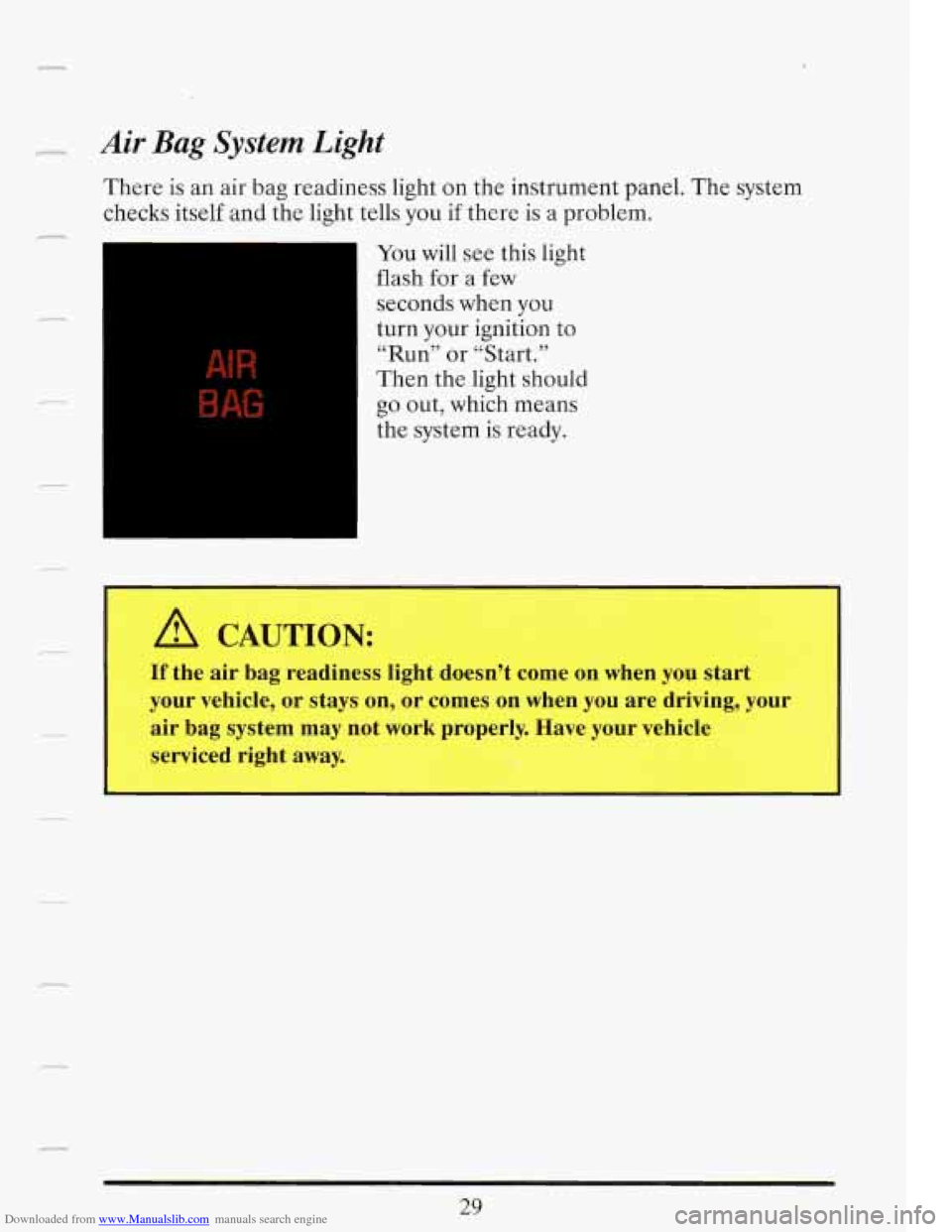
Downloaded from www.Manualslib.com manuals search engine r
Air Bag System Light
There is an air bag readiness light on the instrument panel. The system
checks itself and the light tells you if there is a problem.
1
You will see this light
flash for a few
seconds when
you
turn your ignition to
“Run” or “Start.”
Then the light should
go out, which means
the system
is ready.
A CAUTION:
If the air bag readiness light doesn’t come on when you start
your vehicle, or stays on, or comes on when you are driving, your
air bag system may not work properly. Have your vehicle
’ serviced right away.
29
I-
C
Page 44 of 386
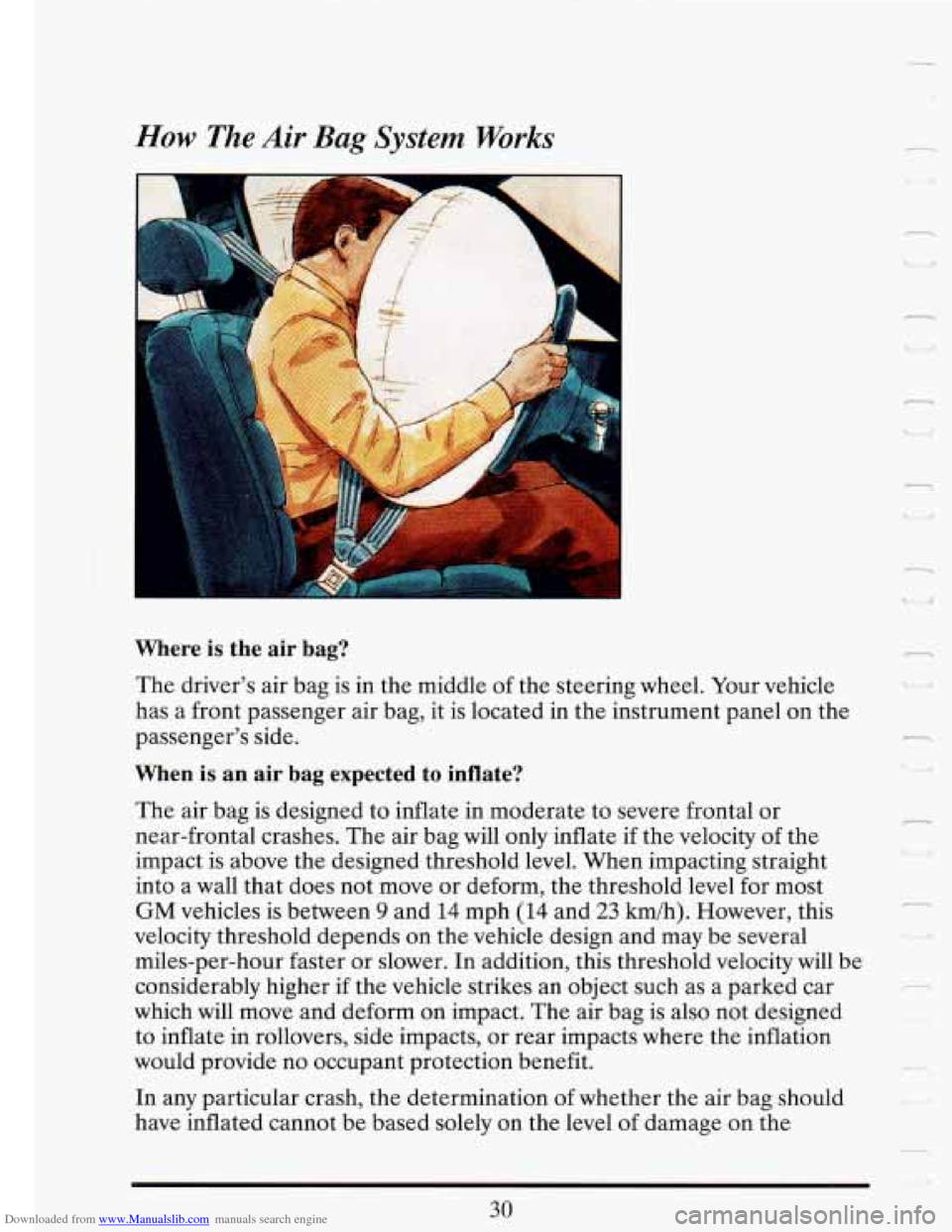
Downloaded from www.Manualslib.com manuals search engine -.
How The Air Bag System Works
.l
n
r
Where is the air bag?
The driver’s air bag is in the middle of the steering wheel. Your vehicle
has a front passenger air bag, it is located in the instrument panel on the
passenger’s side.
When is an air bag expected to inflate?
The air bag is designed to inflate in moderate to severe frontal or
near-frontal crashes. The air bag will only inflate
if the velocity of the
impact is above the designed threshold level. When impacting straight
into a wall that does not move or deform, the threshold level for most
GM vehicles is between 9 and 14 mph (14 and 23 kmk). However, this
velocity threshold depends on the vehicle design and may be several
miles-per-hour faster or slower. In addition, this threshold velocity will be
considerably higher if the vehicle strikes an object such as a parked car
which will move and deform on impact. The air bag is also not designed
to inflate in rollovers, side impacts, or rear impacts where the inflation
would provide no occupant protection benefit.
In any particular crash, the determination
of whether the air bag should
have inflated cannot be based solely on the level
of damage on the
r
n
I
30
Page 45 of 386
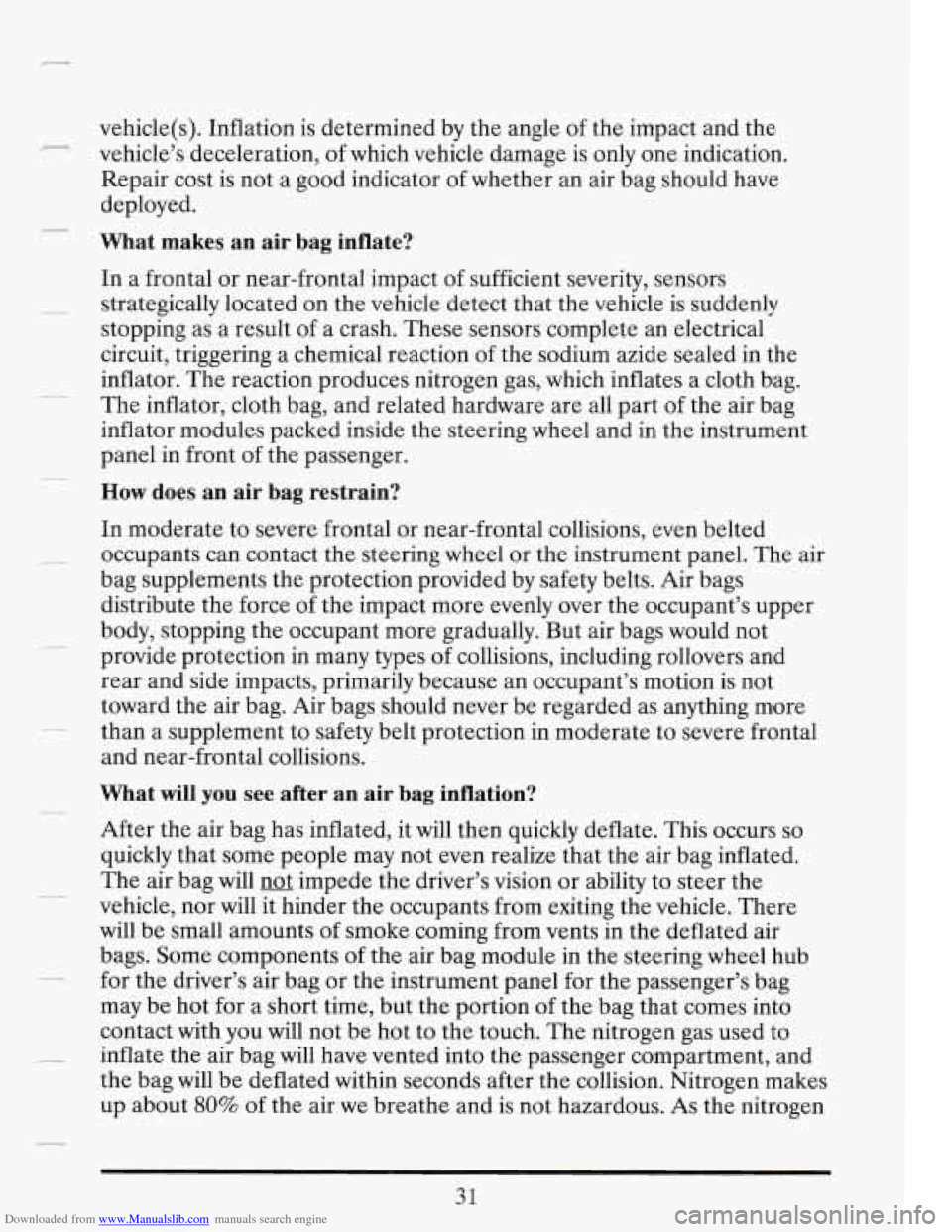
Downloaded from www.Manualslib.com manuals search engine vehicle@). Inflation is determined by the angle of the impact and the
vehicle’s deceleration, of which vehicle damage is only one indication.
Repair cost is not a good indicator of whether an air bag should have
deployed. 2-
_I What makes an air bag inflate?
In a frontal or near-frontal impact of sufficient severity, sensors
- strategically located on the vehicle detect that the vehicle is suddenly
stopping as a result of a crash. These sensors complete an electrical
circuit, triggering a chemical reaction of the sodium azide sealed in the
inflator. The reaction produces nitrogen gas, which inflates a cloth bag.
The inflator, cloth bag, and related hardware are all part of the air bag
inflator modules packed inside the steering wheel and in the instrument
panel in front
of the passenger.
How does an air bag restrain?
In moderate to severe frontal or near-frontal collisions, even belted
occupants can contact the steering wheel or the instrument panel. The air
bag supplements the protection provided by safety belts. Air bags
distribute the force of the impact more evenly over the occupant’s upper
body, stopping the occupant more gradually. But air bags would not
provide protection in many types of collisions, including rollovers and
rear and side impacts, primarily because an occupant’s motion is not
toward the air bag. Air bags should never be regarded as anything more
and near-frontal collisions.
What will you see after an air bag inflation?
__ than a supplement to safety belt protection in moderate to severe frontal
After the air bag has inflated, it will then quickly deflate. This occurs
so
quickly that some people may not even realize that the air bag inflated.
The air bag will
not impede the driver’s vision or ability to steer the
vehicle, nor will it hinder the occupants from exiting the vehicle. There
will be small amounts of smoke coming from vents in the deflated air
bags. Some components of the air bag module in the steering wheel hub
may be hot for a short time, but the portion of the bag that comes into
contact with you will not be hot to the touch. The nitrogen gas used to
inflate the ‘air bag will have vented into the passenger compartment, and
the bag will be deflated within seconds after the collision. Nitrogen makes
up about
80% of the air we breathe and is not hazardous. As the nitrogen
-
-- for the driver’s air bag or the instrument panel for the passenger’s bag
31
Page 46 of 386
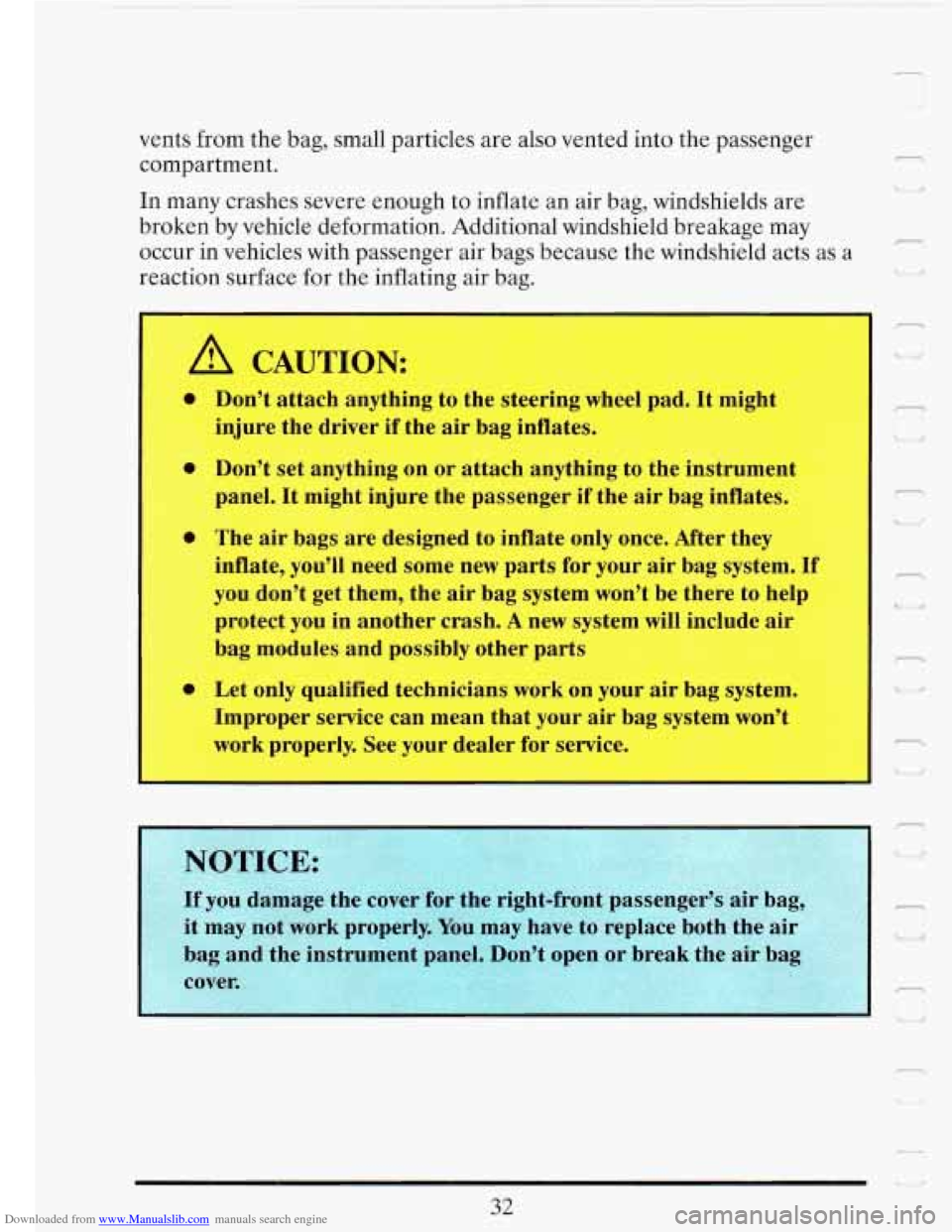
Downloaded from www.Manualslib.com manuals search engine vents from the bag, small particles are also vented into the passenger
compartment.
In many crashes severe enough to inflate an air bag, windshields are
broken by vehicle deformation. Additional windshield breakage may
occur
in vehicles with passenger air bags because the windshield acts as a
reaction surface for the inflating air bag.
A CAUTION:
0
0
0
0
Don’t attach anything to the steering wheel pad. It might
injure the driver if the air bag inflates.
Don’t set anything on or attach anything to the instrument
panel. It might injure the passenger if the air bag inflates.
The air bags are designed to inflate only once. After they
inflate, you’ll need some new parts for your air bag system.
If
you don’t get them, the air bag system won’t be there to help
protect you in another crash.
A new system will include air
bag modules and possibly other parts
Let only qualified technicians work on your air bag system.
Improper service can mean that your air bag system won’t
work properly. See your dealer for service.
n
LI
I-
-
7..
1LJ
m
Ib. Y
LY OTICE.
you damage the cover for the right-front passenger’s air bag,
it may not work properly. You may have to replace both the ai1 :.:...a:. .-_ ,
-.
ZI
32
Page 47 of 386
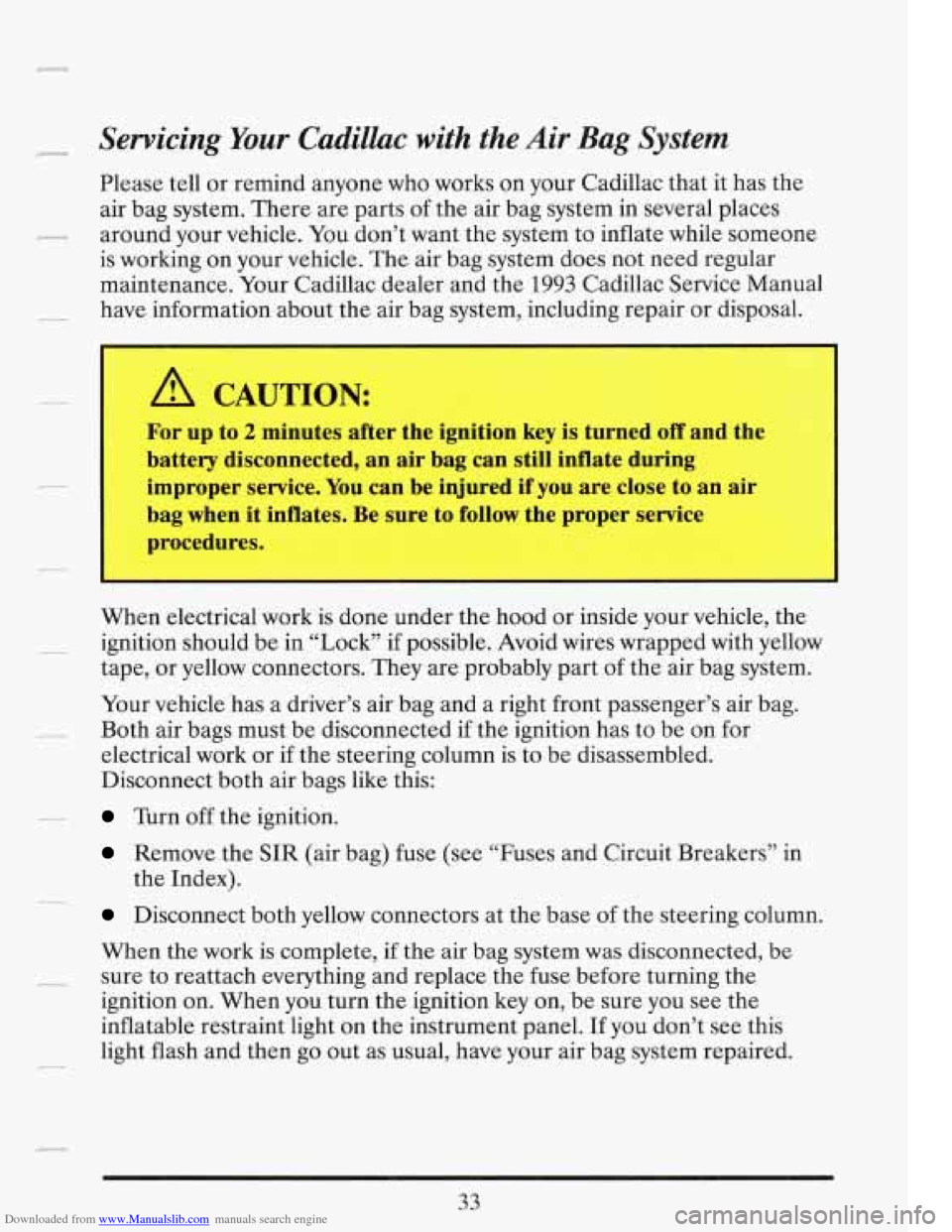
Downloaded from www.Manualslib.com manuals search engine Servicing Your Cadillac with the Air Bag System
Please tell or remind anyone who works on your Cadillac that it has the
air bag system. There are parts of the air bag system in several places
around your vehicle. You don’t want the system to inflate while someone
is working on your vehicle. The air bag system does not need regular
maintenance. Your Cadillac dealer and the
1993 Cadillac Service Manual
have information about the air bag system, including repair or disposal.
I
I
A CAUTION: I
I For up to 2 minutes after the ignition key is turned off and the
battery disconnected, an air bag can still inflate during
improper service. You can be injured if you are close to an air
bag when it inflates. Be sure to follow the proper service
procedures.
I
When electrical work is done under the hood or inside your vehicle, the
ignition should be in “Lock”
if possible. Avoid wires wrapped with yellow
tape, or yellow connectors. They are probably part of the air bag system.
Your vehicle has a driver’s air bag and a right front passenger’s air bag.
Both air bags must be disconnected
if the ignition has to be on for
electrical work or if the steering column is to be disassembled.
Disconnect both air bags like this:
Turn off the ignition.
Remove the SIR (air bag) fuse (see “Fuses and Circuit Breakers” in
Disconnect both yellow connectors at the base of the steering column.
the
Index).
When the work
is complete, if the air bag system was disconnected, be
sure to reattach everything and replace the fuse before turning the
ignition
on. When you turn the ignition key on, be sure you see the
inflatable restraint light on the instrument panel. If you don’t see this
light flash and then go out as usual, have your air bag system repaired.
33
Page 77 of 386
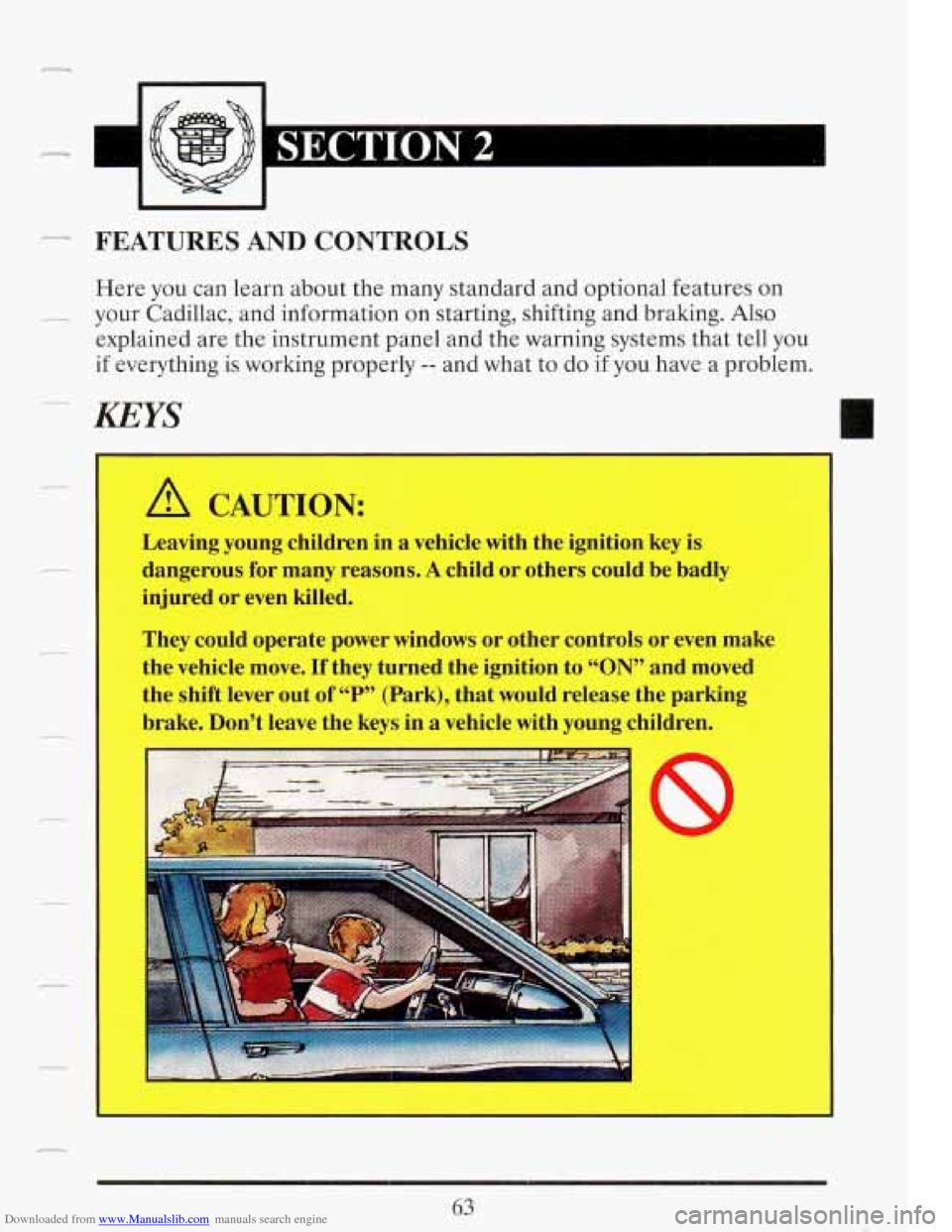
Downloaded from www.Manualslib.com manuals search engine SECTION 2 1
*___ FEATURES AND CONTROLS
Here you can learn about the many standard and optional features on
~ your Cadillac, and information on starting, shifting and braking. Also
explained are the instrument panel and the warning systems that tell you
if everything is working properly -- and what to do if you have a problem.
-- KEYS II
A CAUTION:
Leaving young children in a vehicle with the ignition key is
dangerous for many reasons.
A child or others could be badly
injured or even killed. I
They could operate power windows or other controls or even make
the vehicle move.
If they turned the ignition to “ON” and moved
the shift lever out of “P” (Park), that would release the parking
brake. Don’t leave the keys in a vehicle with young children.
63
,
Page 113 of 386
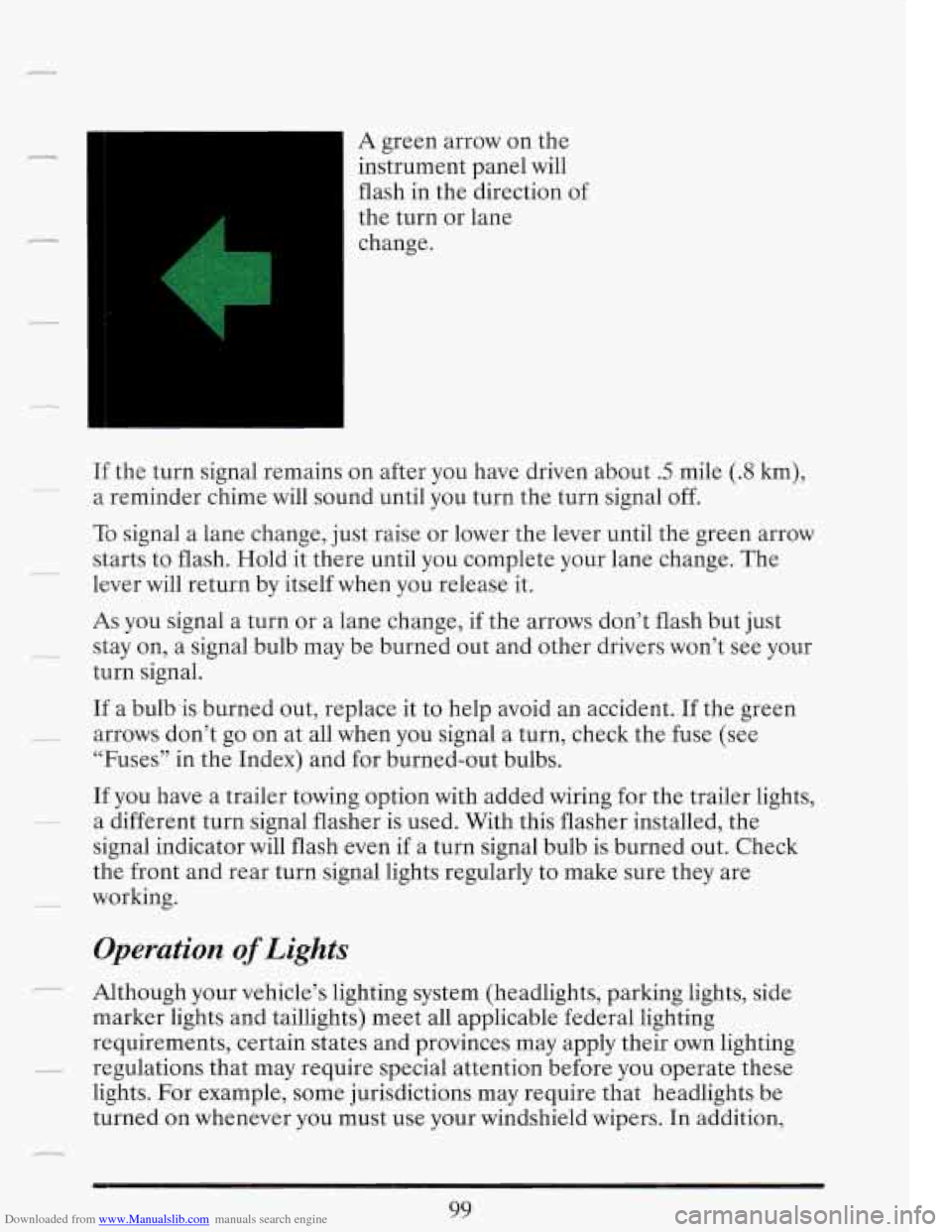
Downloaded from www.Manualslib.com manuals search engine A green arrow on the
instrument panel will
flash in the direction of
the turn or lane
change.
If the turn signal remains on after you have driven about .5 mile (.8 km),
a reminder chime will sound until you turn the turn signal off.
To signal a lane change, just raise or lower the lever until the green arrow
starts to flash. Hold it there until you complete your lane change. The
lever will return by itself when you release it.
AS you signal a turn or a lane change, if the arrows don’t flash but just
stay on, a signal bulb may be burned out and other drivers won’t see your
turn signal.
If a bulb is burned out, replace it to help avoid an accident. If the green
arrows don’t go on at all when you signal a turn, check the fuse (see
“Fuses” in the Index) and for burned-out bulbs.
If you have a trailer towing option with added wiring for the trailer lights,
a different turn signal flasher is used. With this flasher installed, the
signal indicator will flash even if a turn signal bulb is burned out. Check
the front and rear turn signal lights regularly to make sure they are
working.
Operation of Lights
Although your vehicle’s lighting system (headlights, parking lights, side
marker lights and taillights) meet all applicable federal lighting
requirements, certain states and provinces may apply their own lighting
regulations that may require special attention before you operate these
lights. For example, some jurisdictions may require that headlights be
turned on whenever you must use your windshield wipers. In addition,